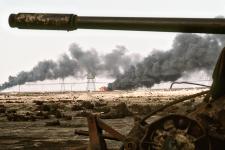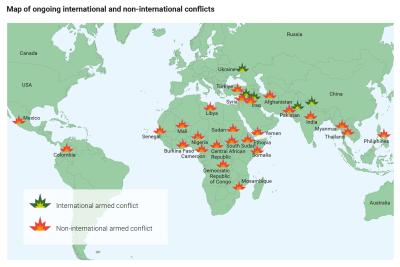Finn Stepputat & Jairo Munive

Armed conflicts cause immense immediate harm to the people affected by them. Therefore, it seems only natural to focus exclusively on the human consequences, downplaying the environmental harm caused by armed conflicts. And although, in some cases, degraded environment and depleted resources like water or fertile soil can be at the root of armed conflict, the environment is frequently a ’silent victim’. However, conflicts can and do cause long-term damage to the environment, whether directly or incidentally, harming people’s health and livelihoods. Attacks and explosive remnants can cause water and soil contamination, or release pollutants into the air. The war in Ukraine, for example, has caused damage to internationally protected wetlands, national parks, and biospheres, and threatens to damage nuclear power plants. During recent fighting in Gaza, incendiary artillery shells set fire to hundreds of tons of toxic pesticides, fertilizers, chemicals, and other farming materials, causing groundwater contamination.
Armed conflict can also result in further indirect environmental degradation. When people flee to camps or cities, the need for food and traditional cooking fuels such as firewood and charcoal can contribute to deforestation and resource depletion. Furthermore, armed conflict occupies government capacities. Environmental protection is not always high on states’ agendas, and they may themselves be involved in the unregulated exploitation of natural resources to sustain armed conflict. But all things being equal, armed conflict risks reducing states’ capacity for protecting the environment, controlling the exploitation of natural resources, and managing forcibly displaced populations during and after conflict. A case in point is Libya, a country affected by long-term armed conflict, where oil spills from ill-maintained power plants, oil fields and offshore installations have resulted in widespread pollution.
The long road to the principles
In late 2022, the UN General Assembly is expected to adopt a set of principles for the Protection of the Environment in Relation to Armed Conflict (PERAC). The principles have been under development for almost two decades and have raised discussions about how to frame them in terms of existing international laws and treaties.
In 1994, at the request of the UN General Assembly, the ICRC published its ‘Guidelines on the Protection of the Natural Environment in Armed Conflict,’ focusing on international conflict. The guidelines are based on international humanitarian law (IHL) and give recommendations for how it can be applied to bestow protection on the environment during armed conflict. An updated version of the guidelines covering both international and non-international conflict was published in 2020. Unlike their 1994 predecessors, the new guidelines aim to serve as a reference for all parties to armed conflict, including non-state armed groups.
Parallel to this process, the UN’s International Law Commission (ILC) has been working since 2013 on a project to analyze and develop legal frameworks that protect the environment in relation to armed conflicts - both international and non-international - and in situations of occupation. In May 2022, the ILC adopted the final version of its 27 draft principles.
Two dimensions of the draft principles are innovative. Firstly, they are based on an analysis of the legal protection afforded to the environment not just during armed conflict, but also prior to and after conflict. Secondly and due to this extension of scope, the draft principles move beyond the laws of war (IHL), drawing from different legal fields such as environmental law, human rights law, arms control, and corporate obligations.

Member States have developed divergent views on the draft principles. The Nordic countries (Denmark, Finland, Iceland, Norway, and Sweden) have adopted a common position which favours a progressive development of legally binding commitments. However, several powerful states, such as Canada, France, Russia, and the US, have adopted more conservative views, rejecting binding commitments beyond existing legal frameworks. Many countries have also objected to efforts to draw on other fields of law than IHL.
Hence, the outcome of the PERAC process is not a new international treaty but rather a normative framework including binding as well as non-binding principles for states and non-state actors (see box).
Moving forward
After conflict, its parties ‘should, as part of a peace process, address (…) the restoration and protection of the environment damaged as a result of the conflict (#22). They ‘should also seek to remove or render harmless toxic or other hazardous remnants of war under their jurisdiction or control’ (#26.1), including ‘remnants of war at sea’ (#27).
With the adoption of the guiding principles, the main challenge involves establishing how they can be productively implemented by governments, militaries, businesses, non-state armed groups and other key actors addressed in the principles. The UN Secretary-General has already propagated actions that would support their implementation. In his ‘Protection of Civilians’ report for 2021, he emphasized that military operations, weak governance, disruption, and neglect resulting from protracted conflict affect the environment and therefore also civilians. To strengthen the protection of civilians, the report recommends improving the understanding of the effects of conflict on the environment; integrating legal protections for the environment into military training and doctrine as well as national laws and policies; and designating particularly important or fragile environments as demilitarized zones.
The Conflict and Environment Observatory suggests that a group of states should take the lead in promoting the principles with other states and relevant stakeholders; that monitoring mechanisms be developed; and that civil society can help in raising awareness about the principles among policymakers and the general public. In any case, while the PERAC process has generated increased interest and a positioning among states, the adoption of the principles in the UN represents a new beginning.
Towards a better understanding
As the UN Secretary-General noted, we need to better understand how armed conflict impacts the environment. Despite the PERAC process, the focus of research remains overwhelmingly on climate change as a driver of conflict, while the impact of conflict-related environmental damage remains somewhat overlooked.
Yet, two recent policy-research initiatives have contributed to the effort: Firstly, a group of five advocacy organizations - the Geneva Peacebuilding Platform, the Environmental Law Institute, PeaceNexus Foundation, the International Union for Conservation of Nature, and the Environmental Peacebuilding Association - have published a White Paper entitled “Future of Environmental Peacebuilding. Nurturing an Ecosystem for Peace”. They aim to advance a policy agenda for environmental peacebuilding, and to foster inter-institutional collaboration for the field. Secondly, SIPRI has published a report entitled “Environment of Peace: Security in a New Era of Risk” which explores how environmental and security issues are converging and how they must be addressed together to reduce risks to peace and security. The reports conclude that environmental action matters more than ever as armed conflicts combine with climate change and environmental degradation to create a new global era of risk. Climate change is not addressed in the principles, but it is widely recognized that damage to the environment aggravates climate change and reduces the buffer function that a healthy environment can have vis-à-vis the effects of climate change.
No comments:
Post a Comment